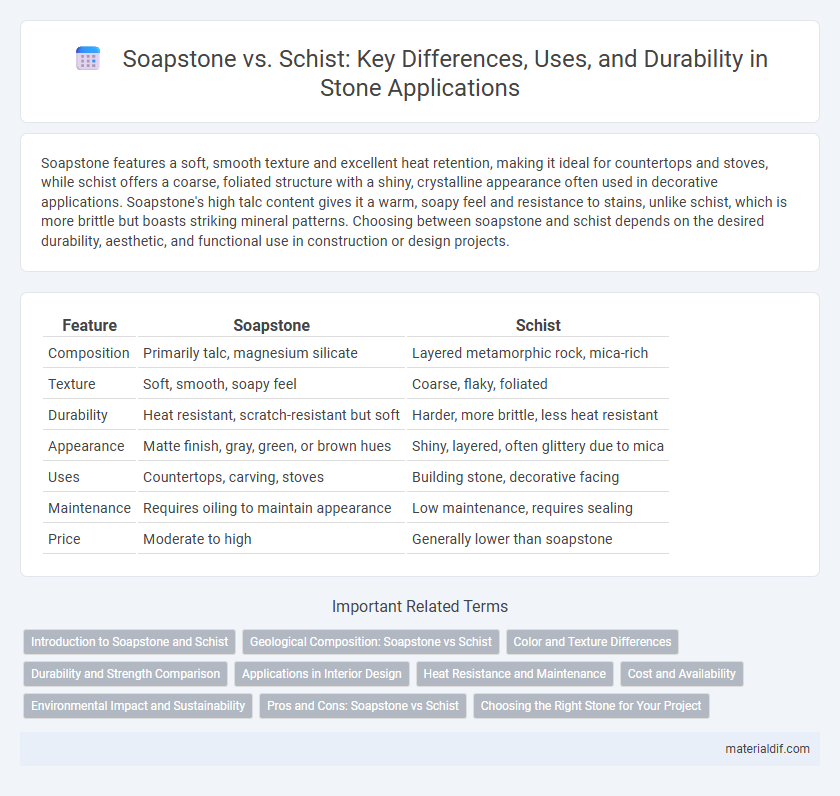Soapstone features a soft, smooth texture and excellent heat retention, making it ideal for countertops and stoves, while schist offers a coarse, foliated structure with a shiny, crystalline appearance often used in decorative applications. Soapstone's high talc content gives it a warm, soapy feel and resistance to stains, unlike schist, which is more brittle but boasts striking mineral patterns. Choosing between soapstone and schist depends on the desired durability, aesthetic, and functional use in construction or design projects.
Table of Comparison
| Feature | Soapstone | Schist |
|---|---|---|
| Composition | Primarily talc, magnesium silicate | Layered metamorphic rock, mica-rich |
| Texture | Soft, smooth, soapy feel | Coarse, flaky, foliated |
| Durability | Heat resistant, scratch-resistant but soft | Harder, more brittle, less heat resistant |
| Appearance | Matte finish, gray, green, or brown hues | Shiny, layered, often glittery due to mica |
| Uses | Countertops, carving, stoves | Building stone, decorative facing |
| Maintenance | Requires oiling to maintain appearance | Low maintenance, requires sealing |
| Price | Moderate to high | Generally lower than soapstone |
Introduction to Soapstone and Schist
Soapstone is a metamorphic rock primarily composed of talc, known for its softness, heat resistance, and smooth texture, making it ideal for countertops, carvings, and heating applications. Schist is a foliated metamorphic rock characterized by its platy minerals like mica, offering a shiny, layered appearance and greater hardness compared to soapstone. Both stones vary significantly in mineral composition, durability, and aesthetic appeal, influencing their practical uses in construction and decorative arts.
Geological Composition: Soapstone vs Schist
Soapstone primarily consists of talc, chlorite, and magnesium-rich minerals, giving it a soft, soapy texture and excellent heat retention properties. Schist is composed mainly of mica, quartz, and feldspar, characterized by its foliated structure and higher hardness compared to soapstone. The significant talc content in soapstone results in easier carving and resistance to acids, while schist's mineral alignment contributes to its distinct layered appearance and structural strength.
Color and Texture Differences
Soapstone typically exhibits a smooth, soapy texture with a matte finish and comes in gentle hues like gray, green, and occasionally reddish-brown. Schist features a more crystalline and rough texture with visible mineral grains, often displaying a range of colors from silver, gray, and brown to greens and purples due to its diverse mineral content. The color of soapstone tends to be uniformly soft, whereas schist shows a layered, shimmering appearance that highlights its foliated structure.
Durability and Strength Comparison
Soapstone exhibits exceptional durability due to its dense and non-porous composition, making it highly resistant to stains and heat, ideal for kitchen countertops. Schist, while offering a visually striking, foliated texture, generally possesses lower strength and can be more prone to flaking and weathering under heavy use. Soapstone's superior hardness and resistance to wear ensure longer-lasting performance compared to the relatively softer and less durable schist.
Applications in Interior Design
Soapstone is highly valued in interior design for countertops, sinks, and fireplace surrounds due to its heat resistance, smooth texture, and ability to develop a soft patina over time. Schist, with its distinctive foliated texture and natural shimmer, is commonly used for feature walls, flooring, and decorative accents, providing a rustic and sophisticated aesthetic. Both stones offer unique visual and functional qualities that cater to different design preferences and practical needs in residential and commercial spaces.
Heat Resistance and Maintenance
Soapstone offers superior heat resistance compared to schist, making it ideal for applications involving high temperatures like countertops near stoves or fireplaces. Its non-porous nature allows for minimal maintenance, as it resists stains and does not require sealing. Schist, while visually appealing with its layered texture, is more porous and susceptible to heat damage, requiring regular sealing and careful upkeep to maintain durability.
Cost and Availability
Soapstone typically costs between $10 to $30 per square foot, making it moderately priced and widely available through specialty stone suppliers and home improvement stores. Schist, often sourced from specific quarries, can vary significantly in price from $15 to $40 per square foot, with availability dependent on regional deposits and demand. Both stones offer unique aesthetics, but soapstone provides more consistent availability and competitive pricing in the market.
Environmental Impact and Sustainability
Soapstone offers a more sustainable choice compared to schist due to its lower environmental impact during extraction and processing, as it requires less energy and produces minimal waste. Schist mining often involves extensive quarrying that can disrupt local ecosystems and generate higher carbon emissions. Soapstone's durability and natural resistance to weathering contribute to its long lifecycle, reducing the need for frequent replacement and conserving resources over time.
Pros and Cons: Soapstone vs Schist
Soapstone offers excellent heat resistance and a smooth, non-porous surface ideal for countertops and fireplaces, but it is softer and prone to scratching compared to schist. Schist boasts a unique, layered texture with strong durability and a natural shimmer, making it suitable for decorative and structural applications, although it can be more brittle and difficult to cut. Both stones vary in maintenance requirements: soapstone resists stains better but shows scratches easily, while schist may require sealing due to its fissured structure.
Choosing the Right Stone for Your Project
Soapstone offers excellent heat resistance and is non-porous, making it ideal for countertops and hearths where durability and stain resistance are crucial. Schist, characterized by its foliated texture and rich mineral content, provides a distinct aesthetic appeal perfect for decorative walls and flooring but may require sealing to prevent moisture damage. Selecting the right stone depends on the project's functional needs and desired appearance, balancing soapstone's resilience with schist's unique visual texture.
Soapstone vs Schist Infographic

 materialdif.com
materialdif.com